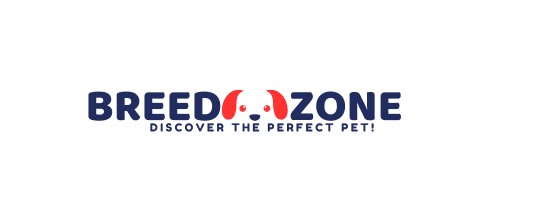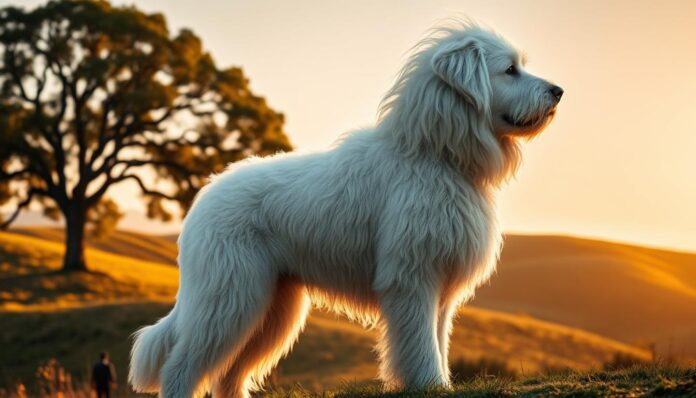The Komondor is a stunning sight with its white corded coat. It has been guarding flocks for centuries. This livestock guardian dog truly embodies the spirit of a guardian.
The Hungarian Sheepdog comes from Hungary and has a long history. It has been a faithful companion to shepherds. Its unique look and strong protective nature make it very valuable.
The Komondor is known for its intelligence, bravery, and loyalty. It is a perfect example of a livestock guardian dog. Its presence shows the strong connection between humans and animals.
The Origin and History of the Komondor
The Komondor has a long history, showing the lasting impact of Hungarian herding dogs. This breed has been closely tied to Hungary’s farming traditions. It has protected livestock for many years.
Ancient Roots in Hungary
The Komondor’s story begins in Hungary, where it guarded sheep from predators. The breed’s distinctive corded coat helped it defend the flocks. It became a formidable guardian of the sheep.
When Hungary was a pastoral society, the Komondor was essential. It protected the flocks from dangers. This role was crucial for the livelihood of many.
Historical Role as Livestock Guardians
The Komondor was known for guarding livestock. Its protective instincts and loyalty were unmatched. It was a valuable companion to Hungarian shepherds.
The Komondor could work alone, making decisions without human help. This skill was highly appreciated.
| Characteristics | Description |
|---|---|
| Protective Instincts | Strong guarding instincts to defend against predators |
| Loyalty | Extremely loyal to the flock and the shepherd |
| Independence | Ability to work independently without human intervention |
The Komondor’s role as a guardian has made it a unique breed. It is admired for its skills and traits.
Physical Characteristics of the Komondor
The Komondor is a large dog with a unique look. It’s both strong and elegant. Its appearance shows it was made to guard and herd.
Size and Build
Komondors are big dogs. Males are at least 27.5 inches tall, and females are at least 25.5 inches. They are built for strength and agility.
They look intimidating but also majestic. They have a strong and sturdy body, making them great guardians.
The Distinctive Corded Coat
The Komondor’s unique corded coat is a standout feature. It’s not just pretty; it also protects against the weather and predators. As the dog grows, the cords form, giving it a rugged beauty.

Keeping the coat clean is important. It prevents mats and keeps the cords healthy and clear.
Facial Features and Expression
The Komondor’s face shows intelligence and alertness. Its dark eyes are full of loyalty and protection.
| Characteristic | Description |
|---|---|
| Size | Males: at least 27.5 inches; Females: at least 25.5 inches |
| Coat | Corded, protective, and distinctive |
| Expression | Intelligent, alert, and loyal |
Komondor Breed Standard
The Komondor breed standard describes the perfect Komondor. It talks about physical traits like size, coat, and structure. It also covers the dog’s temperament, which is key for its job.
American Kennel Club Standards
The American Kennel Club (AKC) welcomed the Komondor in 1937. The AKC breed standard highlights its unique corded coat, strong build, and protective instincts. It also mentions the Komondor’s size, shape, and expression, focusing on its role as a guardian.
International Breed Recognition
Worldwide, kennel clubs like the FCI (Fédération Cynologique Internationale) know the Komondor. The breed standard is mostly the same everywhere, focusing on its unique corded coat and guarding abilities. This shows the breed’s importance and its ability to thrive in different places.
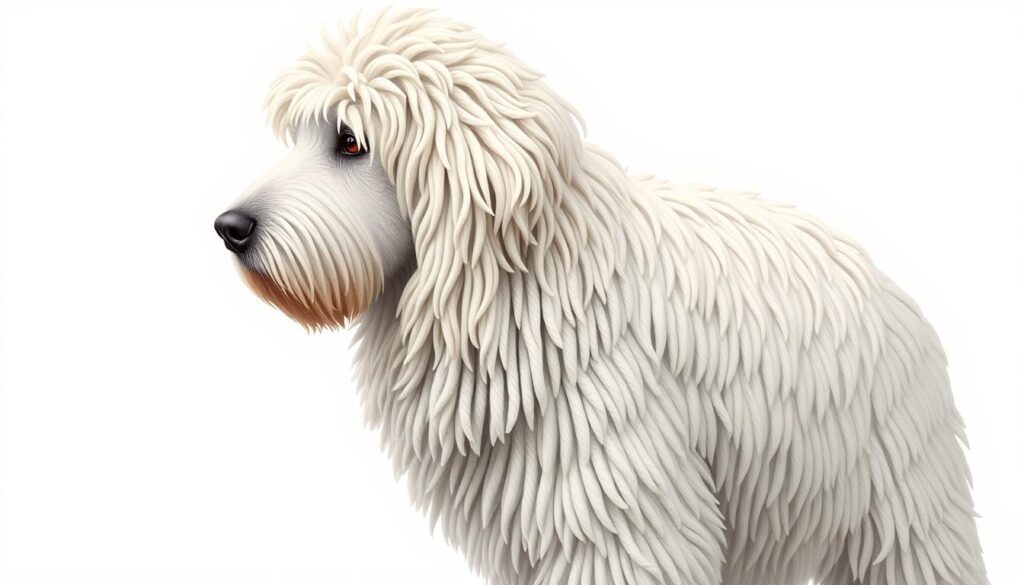
The Unique Corded Coat: Development and Purpose
The Komondor’s corded coat is truly fascinating. It makes the breed stand out and has important uses. This coat developed because the Komondor was a livestock guardian in Hungary.
How the Cords Form Naturally
The Komondor’s coat forms cords naturally as it grows. Puppies start with soft, fluffy fur. By 8 to 12 months, this fur mats into cords.
Puppy to Adult Coat Transition
The coat change from puppy to adult is slow. As the puppy grows, its coat evolves into the famous cords.
Full Cord Development Timeline
It takes up to two years for the coat to fully develop. During this time, regular grooming is crucial to prevent matting and ensure the cords form right.
Protective Function Against Predators and Weather
The corded coat protects against predators and harsh weather. Its thickness makes it hard for predators to grasp the dog. It also keeps the dog warm in cold weather.
Camouflage Among Sheep Flocks
The coat also helps the Komondor blend in with sheep. The white cords look like sheep, helping the Komondor guard the flock without being seen.
The corded coat is key to the Komondor’s success as a guardian. It’s a unique feature that makes the breed both effective and beloved.
You May Like:- Discover the Loving Personality of the Field Spaniel
Temperament and Personality Traits
The Komondor is known for its intelligent and loyal nature. They are protective and have been valued as guardians for centuries. Their temperament combines guardian instincts, family loyalty, and a unique approach to strangers.
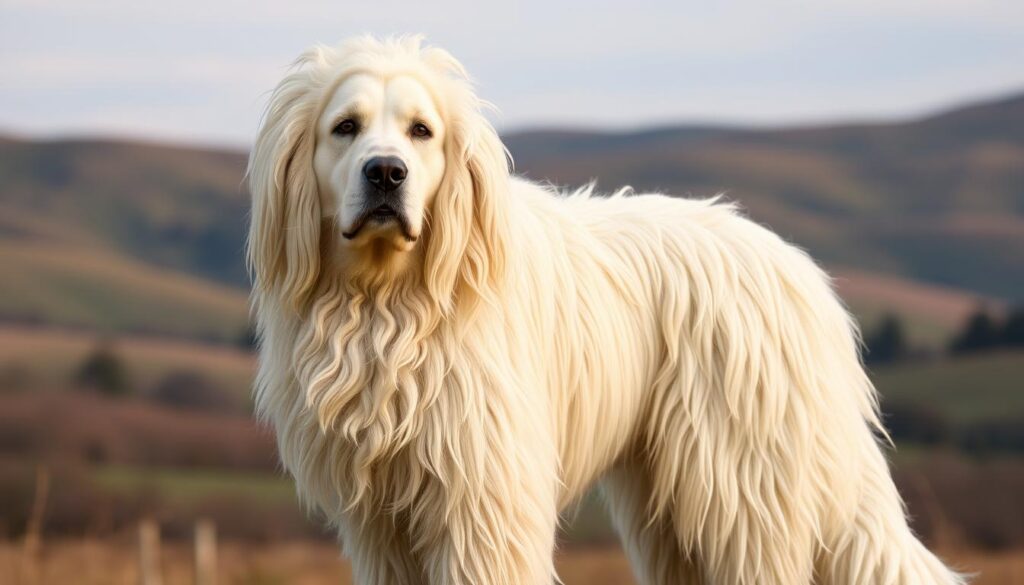
Guardian Instincts
Komondors have a strong protective dog breed nature. This comes from their history as guardians of livestock. They are naturally wary of strangers and threats, thanks to their intelligence.
Family Loyalty and Protectiveness
Komondors are extremely affectionate with their family. They are loyal dog companions and form strong bonds. They are gentle with children, showing a nurturing side.
This mix of protectiveness and affection makes them great family pets. They are perfect for those who understand their unique traits.
Behavior with Strangers
Komondors are cautious around strangers, a trait that helps them as guardians. They may seem aloof at first but are not aggressive unless provoked. Early socialization is crucial to help them distinguish between friendly strangers and threats.
| Temperament Trait | Description |
|---|---|
| Guardian Instincts | Strong protective nature, naturally wary of strangers |
| Family Loyalty | Affectionate with family, gentle with children |
| Behavior with Strangers | Cautious, reserved, not typically aggressive unless provoked |
The Komondor as a Working Dog
The Komondor has been a guardian of livestock for centuries. It uses its strong protective instincts and sharp senses to protect farms and ranches.
Traditional Herding and Guarding Roles
The Komondor guards livestock from predators like wolves and bears. This breed has been key in protecting herds. It uses its size, strength, and unique coat to scare off threats.
Modern Working Applications
Today, the Komondor still works as a guardian dog. It has adapted to new roles while keeping its guarding instincts sharp.
Farm and Ranch Work
On farms and ranches, the Komondor guards sheep, cattle, and goats. It helps lower losses from predators.
Property Protection
The Komondor also protects property. Its scary look and loyal heart scare off intruders.
| Working Role | Description |
|---|---|
| Livestock Guarding | Protects sheep, cattle, and other livestock from predators. |
| Property Protection | Guards property and deters intruders due to its intimidating appearance and loyal nature. |
Training and Socialization Requirements
Komondors are smart and strong-willed, needing a solid training and socialization plan. Their independent streak can make training tough. But, with the right strategy, they can learn to obey and be loyal friends.
Early Socialization Importance
Early socialization is crucial for Komondors. It helps them get used to different places, people, and animals. This builds their confidence and lowers the chance of aggression. A well-socialized Komondor stays calm in new situations.
Introducing the puppy to various stimuli, like sounds and smells, in a positive way is key. This early exposure shapes their personality and ensures they grow up well-adjusted.
Obedience Training Challenges
Obedience training for Komondors is tough because of their independent nature. They are smart but can be stubborn. A patient, consistent, and positive trainer is needed. Positive reinforcement is essential to encourage good behavior without stress.
A structured training plan with clear commands and rewards helps. Keeping training sessions fun and rewarding keeps the dog interested.
Working with the Komondor’s Independent Nature
The Komondor’s independent nature is both a strength and a challenge. It makes them great guardians but requires creative and persistent training. It’s important to understand and respect their independence while setting clear boundaries.
| Training Aspect | Komondor’s Independent Nature | Training Approach |
|---|---|---|
| Obedience | Can be stubborn | Consistent, positive reinforcement |
| Socialization | May be wary of strangers | Early, gradual exposure |
| Guarding Instinct | Strong protective instincts | Channeling instincts through training |
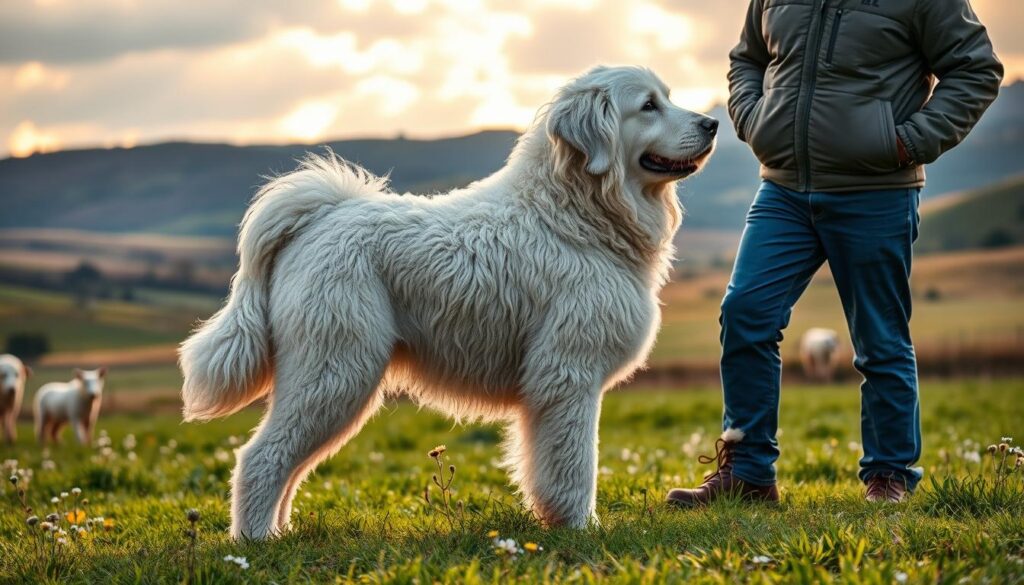
By understanding and working with their independent nature, trainers can build a strong bond with their Komondor. They can use their natural guarding instincts and intelligence to make a well-behaved and loyal companion.
Health Considerations for the Komondor Breed
The Komondor is a large and majestic breed with specific health concerns. They are generally healthy but can face issues common in big dogs.
Common Health Issues
Komondors may deal with hip dysplasia and eye conditions. These problems can greatly affect their quality of life.
Hip Dysplasia
Hip dysplasia is common in big breeds like the Komondor. It’s a genetic issue that can cause arthritis and mobility problems.
Eye Conditions
Komondors can get eye issues like cataracts and progressive retinal atrophy. Regular eye checks are key for early detection and care.
Other Breed-Specific Concerns
Komondors may also face gastric torsion and autoimmune disorders. These are additional health risks to be aware of.
Lifespan and Aging Concerns
Komondors live between 10 to 12 years on average. As they get older, they may face health problems like mobility decline and disease susceptibility.
Preventative Health Care
Regular vet visits, a balanced diet, and exercise can prevent many health issues in Komondors. Owners should be ready to invest in their dog’s health care.
| Health Issue | Description | Preventative Measures |
|---|---|---|
| Hip Dysplasia | Genetic condition affecting the hip joint | Regular check-ups, maintaining healthy weight |
| Eye Conditions | Includes cataracts and progressive retinal atrophy | Regular eye exams |
| Gastric Torsion | Life-threatening condition requiring immediate veterinary attention | Feeding multiple small meals, avoiding exercise after meals |
Grooming and Maintenance of the Corded Coat
The corded coat of the Komondor is not just a visual trait; it requires meticulous care. This coat, which forms cords over time, is key to the dog’s unique look. Knowing how to groom and maintain this coat is essential for any Komondor owner.
Cord Formation and Development
The cords of the Komondor’s coat develop as the dog matures. At first, the coat is soft and woolly. But as the dog grows, the outer coat becomes coarser and curlier, intertwining with the undercoat to form the characteristic cords. This process is natural, but it requires careful handling to ensure the cords form correctly.
Bathing and Drying Techniques
Bathing a Komondor is a delicate process. It’s essential to use a mild shampoo and to ensure that the coat is thoroughly rinsed to prevent dirt and soap buildup. After bathing, drying is equally critical. The coat must be dried carefully to prevent matting, with some owners using a combination of air drying and gentle heat.
Regular Maintenance Requirements
Regular maintenance of the Komondor’s coat involves several tasks. Cord separation is a crucial aspect, where the cords are gently separated to prevent them from matting together. This task is time-consuming but essential for maintaining the coat’s health and appearance.

Cord Separation
Cord separation involves gently teasing apart the cords, especially at the roots, to prevent matting. This task requires patience and a gentle touch to avoid damaging the coat.
Preventing Matting and Dirt Buildup
In addition to cord separation, regular inspection and cleaning of the coat are necessary to prevent dirt buildup and matting. This includes checking for any debris that may be trapped within the cords and ensuring that the coat remains clean and healthy.
By following these grooming and maintenance practices, Komondor owners can ensure their dog’s coat remains healthy and visually striking. While the task may seem daunting, the reward is a well-groomed Komondor with a coat that is both functional and aesthetically pleasing.
The Komondor as a Family Pet
The Komondor is known for its unique look and loyalty. It’s a great family pet because it’s loving and gentle, especially with children. But being a family pet means more than just being friendly with family.
Compatibility with Children
The Komondor is extremely affectionate with kids. They are patient and gentle, making them perfect playmates. But, it’s important to socialize them well to keep them calm and comfortable around children.
Interaction with Other Pets
Komondors have a guarding instinct. They might be wary of other animals if not socialized right. Early and slow socialization helps them live peacefully with other pets in the home.
Space and Exercise Needs
Komondors need regular exercise to be happy and healthy. They love to run and play, so they need lots of space. This can be a yard or a big living area. They need walks and playtime to avoid boredom and bad behavior.
Breeding and Puppy Selection
Breeding Komondor dogs needs a deep understanding of the breed standard. It also requires a commitment to responsible breeding practices. This means following the breed’s physical traits and ensuring the puppies’ health and temperament.
Responsible Breeding Practices
Good breeders care deeply about their dogs’ welfare. They follow practices that improve the breed’s health and temperament. This includes:
- Conducting health tests on breeding dogs to identify potential genetic issues.
- Ensuring that breeding dogs are temperamentally sound, making them suitable for family environments or working roles.
- Limiting the number of litters per year to avoid overbreeding and ensure the health of the mother.
Responsible breeding also means that breeders often take back dogs of their breeding that need homes. They work with the new owner to find a suitable second home. This shows their commitment to the dogs’ lifelong welfare.
What to Look for in a Komondor Puppy
When choosing a Komondor puppy, consider several factors. This ensures you’re getting a healthy, well-adjusted dog:
| Characteristic | Description |
|---|---|
| Physical Health | Look for signs of good health, such as clear eyes, clean ears, and a robust build. |
| Temperament | The puppy should be curious and alert, not overly aggressive or fearful. |
| Parental Health Clearance | Ensure the parents have been health tested for common Komondor issues. |
Preparing for a Komondor Puppy
Before getting a Komondor puppy, prepare your home and family. This includes:
Ensuring your home is puppy-proofed, having the necessary supplies, and understanding the commitment to training and socialization. This is needed for a well-adjusted adult dog.
Conclusion: Is the Komondor Right for You?
Having a pet is a big responsibility. It requires care, dedication, time, and effort. But, it’s all worth it for the love and loyalty you get back. The Komondor, with its protective nature, fits this bill perfectly.
The Komondor’s corded coat and guardian instincts make it stand out. But, owning one isn’t for everyone. It needs owners who are ready to train, socialize, and groom it.
If you’re up for the challenge, the Komondor can be a great addition. It offers loyalty, protection, and companionship. Before getting a Komondor, think about if your lifestyle and abilities match its needs.
FAQ
What is the origin of the Komondor breed?
The Komondor is an ancient Hungarian breed. It was used to guard livestock from predators.
What are the distinctive physical characteristics of the Komondor?
The Komondor is a large dog with a muscular build. It has a unique corded coat. This coat protects it from the weather and predators.
How does the Komondor’s corded coat develop?
As the Komondor grows, its coat develops into cords. This happens naturally. The undercoat and topcoat intertwine to form these cords.
What is the Komondor’s temperament like?
The Komondor is fiercely protective and loyal. It makes a great guardian and companion.
Is the Komondor suitable as a family pet?
Yes, but only for experienced owners. They need space, exercise, and training. Its protective nature requires careful consideration.
How much grooming does a Komondor require?
Komondors need regular grooming. This prevents matting and tangling of their coat. They require baths and drying techniques.
What health issues are common in the Komondor breed?
Komondors can get hip dysplasia and eye problems. Regular health care is essential to prevent these issues.
How long does a Komondor typically live?
Komondors live about 10-12 years. Their lifespan depends on health care and living conditions.
What are the training requirements for a Komondor?
Komondors need early socialization and obedience training. They are independent and require patient handling.
Can Komondors be used as working dogs?
Yes, Komondors excel as working dogs. They are great at herding and guarding. Their protective instincts and intelligence make them perfect for these roles.

